August 4, 2022
3.1 mins read
Why Should Property Managers Invest in Pre-Season and Post-Season Site Inspections
Performing proactive maintenance is estimated to reduce equipment repair costs by 40 to 60 percent annually. Along with a seasonal scheduled maintenance program, a pre and post-season inspection can identify additional areas that may require proactive maintenance or unplanned repairs.
Property managers are liable to invest in property investigation and maintenance, whether pre-season or post. When the harsh winter hits, many parts of the property will likely take the brunt of it and sport numerous damages once the season passes. Due to this, it is crucial to inspect the property before and after the season to identify issues in areas like driveways, parking lots, curbs, signages, catch basins, building envelopes, lighting, fencing, etc., and fix them before they become larger more costly issues. Below is an elaborate discussion of why a pre-season and post-season inspection should be a required service.
To Reduce the Risk of Safety Hazards
Winters can be a dreadful season for property managers as the safety of everyone on their property rests upon them. Initiating a property inspection before the winter strikes can help to identify any issues with the property. Understanding that small potholes and cracks in the pavement can turn into large potholes and hazards, burnt-out or broken lighting becomes a larger safety hazard when daylight is limited, and signage is important to patron safety is of utmost importance to a safe winter season.
To Identify Areas That Deteriorate Faster in Harsh Weather
Canadian winters can be particularly harsh on asphalt and concrete. If small issues are neglected through just one winter season, the damage can become unrepairable and require a full replacement. Having minor issues examined by a professional and reported seasonally will allow you to choose an option to give you the longest life out of your property.
To Show Due Diligence in Case of a Liability Claim
Visitors on the property can fall prey to the harsh weather, leading to a liability claim. It is another motivation for property owners to thoroughly check the property for any potential damages or hazards before the season while also ensuring the property is maintained after the harsh season. Inspecting the property for any pre or post-season damages can significantly decrease the chances of a liability claim, as well as show due diligence, which helps the property managers circumvent any lawsuits.
To Improve Property Value Through Proactive Maintenance
Overlooking property maintenance before the winter strikes can substantially increase the risk of damages during harsh winter seasons. Alternatively, an inspection can highlight the areas at highest risk and following that, it’s just a few repairs here and there, and your property is good to go. This will help maintain the curb appeal for the property and increase its value immensely.
To Allow for Budget Planning for Your Five-Year Maintenance Plan
Inspecting the asphalt post-season and pre-season gives property managers a good idea of the condition of the same. Depending on the state of the asphalt, they can articulate a property maintenance plan along with budget planning for the next five years.
To Repair Any Urgent Issues Before the Seasons
Once the snow covers the entire pavement, there is little to no maintenance that can be done. It’s only when the harsh weather retreats that they can repair the damages. Any inspection and repairing, like potholes or cracks, broken curbs, or catch basins, should be taken as a priority to prevent any further damage to them due to the snow. When thaw and melt occur, you don’t want to be left with floods and further water damage either.
GRM Inc is a property maintenance expert that helps property managers to reverse the damage of harsh weather. Contact us today to keep your property safeguarded and optimize your maintenance budget.

